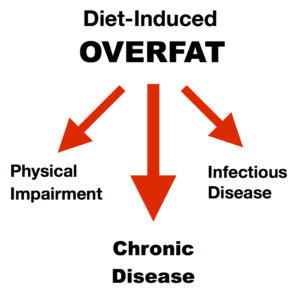
What we need now is public health not politics
Theodore Roosevelt said: “No country can be strong whose people are sick and poor.” This is applicable today as a strong world is a healthy and economically sound world. Can we relearn that lesson after COVID-19?
Now that the world has started reopening, we can’t just go back to business as usual. Many have said that’s what first got us in trouble. So it’s time to address the real issues rather than spew rhetoric and blame.
Enter Plan A+
While the rhetoric on recovery has started, only a true recovery can restore social, economic and health stability. It must address the causes of the problem, not just treat the symptoms. One of the common causes simply is sugar because it created the overfat pandemic, which is far worse than the COVID-19 pandemic.
Plan A+ implements realistic actions now that can correct the causes of poor health that make us vulnerable to future pandemics, chronic disease and escalating healthcare costs. It’s a tactical approach to obtain results measured in months not decades. And it won’t even cost anything.
Most of us want a rapid, effective recovery, but nobody wants just window-dressing. Will the world really do it — or will we just go back to business as usual?
Dueling Pandemics
Preventing the next major pandemic means dealing with the other, hidden pandemic, one that quietly has grown into a monster during the last half century, costing trillions of dollars each year while raising the risk of infectious disease. This was spelled out in my recent scientific publication with Professor Paul Laursen: The Perfect Storm: COVID-19 pandemic meets overfat pandemic, published in the April 2020 issue of Frontiers in Public Health. (A summary and link to the paper is here.)
This clash of two dangerous pandemics makes for the perfect storm for global health and economic disaster. We described how excess body fat, called overfat, now affecting over 80 percent of the world, impairs immunity making people more vulnerable to infectious disease and future pandemics.
Overfat also causes most chronic illness, including cardiovascular disease, diabetes, cancer, Alzheimer’s and others that, most importantly, are not only preventable, but further increase the risk of infectious disease. This is the vicious cycle that existed before the COVID-19 pandemic, and it will not be broken until it’s fixed. This is the goal of Plan A+.
Sugar-coated Economy
Plan A+ is relatively simple, practical, rapidly effective with measurable improvements, albeit politically uncomfortable and the junk-food industry won’t like it. It’s not bogged down with red tape but just one primary focus: to attack the cause of overfat — sugar and other refined carbohydrates. In doing so, improvements in downstream poor health, which also include chronic physical impairment and the many risk factors that are precursors to infectious disease, can quickly follow.
Unfortunately, we have an economy that is built on sugar as well as the ill health it creates. While sugar is a major commodity in the world economy, it was not long ago that sugar was also singled out as a significant factor that could wreck it.
The ongoing booming healthcare sector on Wall Street has made trillions of dollars for investors, thanks to sick people. All while healthcare continues to be one of the biggest drains on the global economy; it’s one big bubble getting bigger. The world is unable to care for all the sick, as triage is becoming more common.
A 2015 Morgan Stanley Research report on Sustainable Economics, called The Bitter Aftertaste of Sugar, forecasted higher healthcare costs, lower productivity, and economic disaster unless something changes. They cite sugar as the culprit.
Social Distance from Sugar
Sugar is what gives junk food its punch. Population-wide habit changes succeeded in the past: consider the reductions in the use of tobacco. (In case you missed it, sugar is the new tobacco.)
Plan A+ addresses diet-induced overfat fast, including:
- Public health campaigns everywhere encouraging individuals to avoid sugar and junk food.
- Ban junk food advertising, especially for children, just like tobacco.
- Replace those ads by incentivizing companies to promote healthy vegetables, fruits, meats, eggs, etc.
- Promote healthy food as affordable, despite the myth that junk food is cheaper.
Other, stronger successful strategies include:
- A junk food tax. Add or increase taxes on all junk foods without exceptions.
- Pay people to get and stay healthy.
- Make healthy foods less expensive to buy.
- Stop government subsidies and other encouragement of junk food production, including banning junk food lobbyists.
- Incentivize consumers to choose healthy foods other ways, such as helping farmers grow healthy food, reduced organic food fees, tax breaks, etc.
Consider this example: In the last decade alone, retail tobacco product prices have risen almost 90 percent, reducing sales and impacting consumer health.
If a candy bar costs $5, and an apple is 50 cents, well, you get the message.
These changes can save untold amounts of money, more than offsetting costs to implement them.
The good news is that deleting sugar and other junk food and replacing it with healthy food produces amazingly rapid results. For example, dumping sugar can reduce or eliminate disease risk factors such as hypertension and high triglycerides in two weeks, and quickly reduce or eliminate medication, pain, along with weight and body fat. One study (in the journal Obesity, Lustig et al. 2016) demonstrated that reducing dietary sugar reversed cardiovascular and metabolic disease in children, including high cholesterol, hypertension, and nonalcoholic liver disease, in only nine days!
Public Health without Politics
Can we really mobilize for Plan A+ fast? Yes, we just had a global dress rehearsal: rapid changes were implemented early in 2020. We can quickly do the same with Plan A+.
There’s no doubt that in the short term we can recover from COVID-19. The real question is whether politicians will address the current global health crisis and help shape a better world. Just in case, Plan A+ has another unique feature.
Personalize the Plan
There’s only one Plan A+ that’s practical, cheap, and effective with the potential for rapid results, significantly improving global health and prevent future pandemics.
The most important COVID-19 lesson relearned is that lifestyle significantly influences our health. Most of us choose our lifestyle, and practicing self-care can help personalize better health. While the goal of Plan A+ is better health for all, it begins with a global grassroots effort — it won’t work without individuals. So volunteer to be healthy!
Sure, it needs more detail and polishing. The question is what can we do with all the money we save?
Plan A+ could quickly, inexpensively and effectively improve overall global health and prevent future pandemics. Some of us who choose a heathy lifestyle and practice self-care have already embraced it.
References
https://philmaffetone.com/physiology-journal-publishes-maf-method/
Revisiting the Global Overfat Pandemic. https://philmaffetone.com/global-overfat-pandemic-worse-than-previously-thought/
Garg S, et al. Hospitalization Rates and Characteristics of Patients Hospitalized with Laboratory-Confirmed Coronavirus Disease 2019 — COVID-NET, 14 States, March 1–30, 2020. MMWR Morb Mortal Wkly Rep 2020;69. doi: http://dx.doi.org/10.15585/mmwr.mm6915e3









